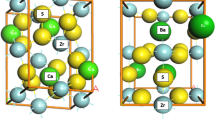Abstract
Starting from the phenomenological equations which describe the currents of the four specific ice lattice defects (OH3 +, OH−, doubly occupied and vacant hydrogen bonds), the electrochemical and the homogeneous thermoelectric power are calculated for the currentfree steady state under the assumption of immobile chemical impurities. The expression for the homogeneous thermoelectric power agrees with the experimental value (1.8 mV/°C) if the energy values obtained from the electrical properties are inserted, and if the diffusivity ratios of the ions D−/D+ and of the valence defects DL/DD are assumed to be much smaller than unity and 1.2, respectively. The formulae are also applied to ice doped with hydrofluoric acid, and the magnitudes of the Seebeck, Peltier and Thomson effects are derived.
Résumé
En partant des équations phénoménologiques qui décrivent les courants des quatre défauts spécifiques de la glace (OH3 +, OH−, valences hydrogène vides et doublement occupées) on calcule le potentiel thermoélectrique homogène et le potentiel électrochimique dans le cas stationnaire statique, en supposant que les impuretés chimiques sont immobiles. L'expression du potentiel thermoélectrique correspond à la valeur expérimentale (1,8 mV/°C) si on y introduit les énergies obtenues par la mesure des propriétés électriques, et si on suppose que le rapport des coefficients de diffusion des ions D−/D+ et des défauts de valence DL/DD sont resp. beaucoup plus petit que l'unité et égal à 1,2. Les formules s'appliquent également à la glace dotée d'acide fluorhydrique et on en tire les grandeurs des effets Seebeck, Peltier et Thomson.
Zusammenfassung
Das elektrochemische Potential und das homogene, thermoelektrische Potential werden für den stromlosen, stationären Zustand unter der Annahme der Unbeweglichkeit der chemischen Verunreinigungen berechnet. Dafür wird von den phänomenologischen Gleichungen ausgegangen, die die Ströme der vier für Eis spezifischen Gitterdefekte beschreiben (OH3 +, OH−, doppelt besetzte und leere Wasserstoffverbindungen). Der Ausdruck des thermoelektrischen Potentials stimmt mit dem experimentellen Wert (1,8 mV/°C) überein, wenn die aus den elektrischen Eigenschaften gemessenen Energien eingesetzt werden, und wenn das Diffusionskoeffizientenverhältnis der Ionen D−/D+ viel kleiner als eins und dasjenige der Orientierungsfehler DL/DD zu 1,2 angenommen wird. Die Formeln werden auch auf das mit Fluorwasserstoffsäure verunreinigte Eis angewandt und die Größen der Seebeck-, Peltier- und Thomson-Effekte abgeleitet.
Similar content being viewed by others
Bibliography
Latham, J., andB. J. Mason: Proc. Roy. Soc. (London) A,260, 523 (1961).
Jaccard, C.: Helv. Phys. Acta32, 89 (1959).
Gränicher, H.: Phys. kondens. Materie1, 1 (1962).
Eigen, M., andL. de Maeyer: Proc. Roy. Soc. (London) A,247, 505 (1958).
de Groot, S. R.: Thermodynamik irreversibler Prozesse. Bibliographisches Institut, Mannheim (1960).
Author information
Authors and Affiliations
Rights and permissions
About this article
Cite this article
Jaccard, C. Thermoelectric effects in ice crystals. Phys kondens Materie 1, 143–151 (1963). https://doi.org/10.1007/BF02422466
Received:
Issue Date:
DOI: https://doi.org/10.1007/BF02422466




